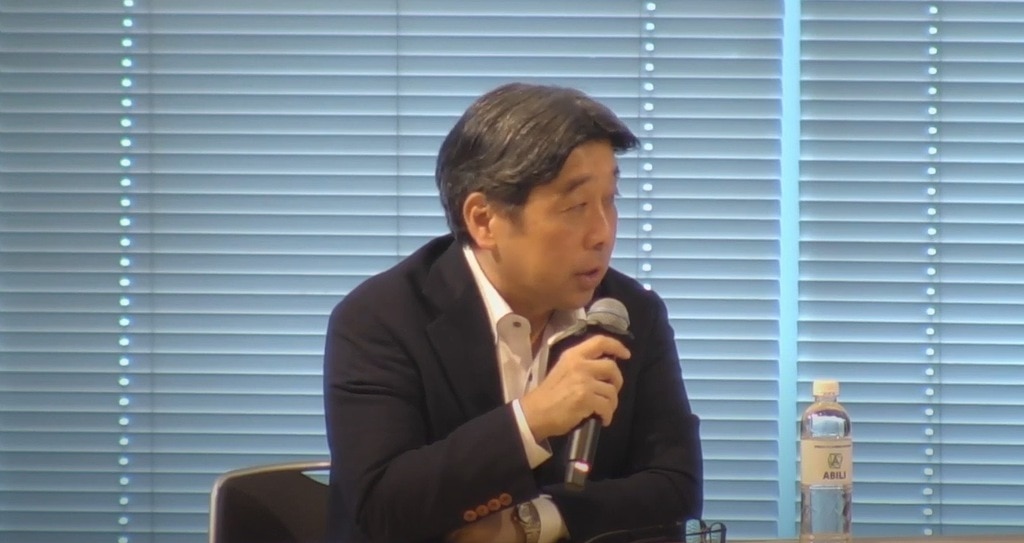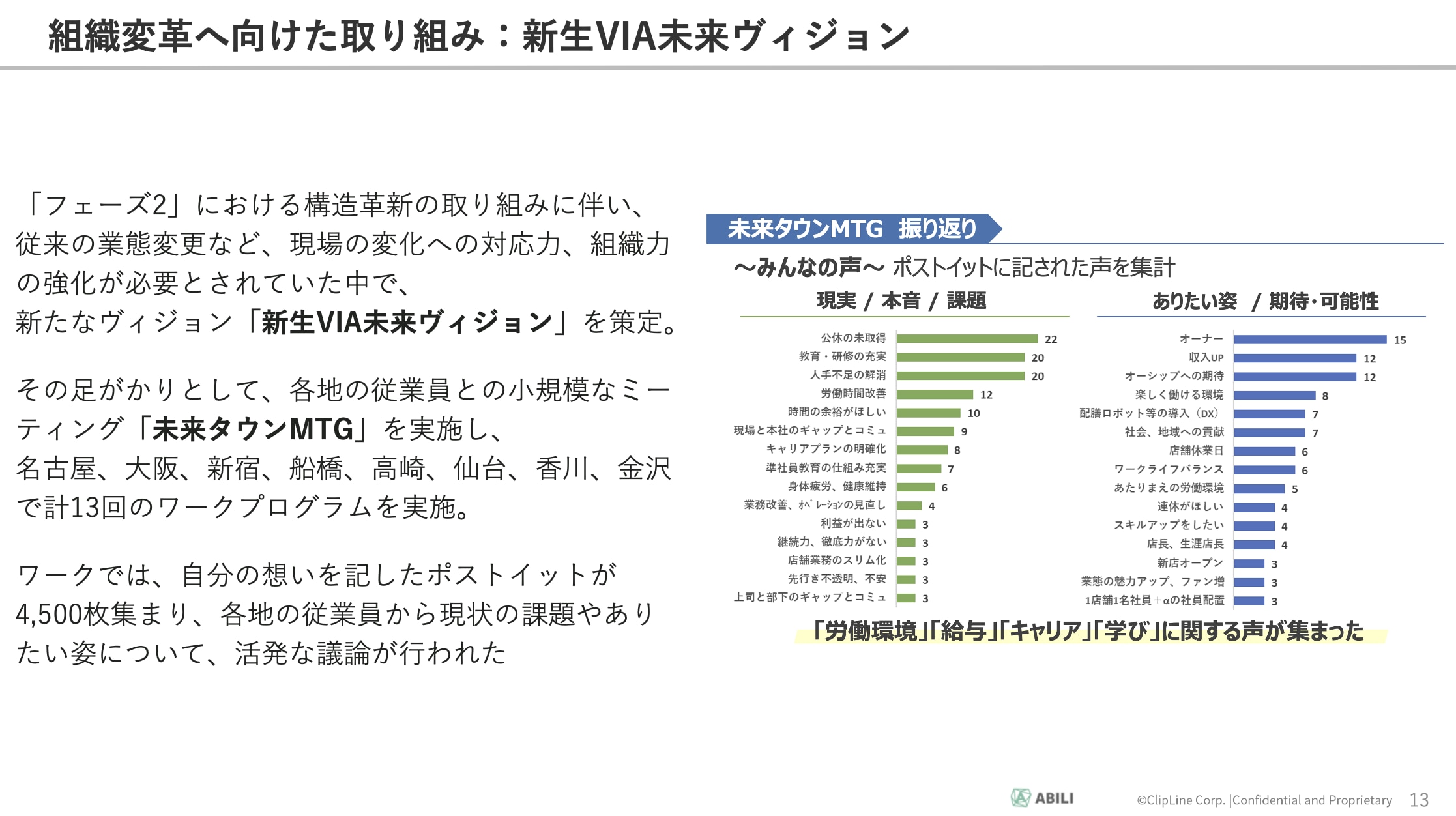
How to motivate staff and generate growth
Key points to learn from companies
that have achieved V-shaped recovery
<Corporate Leadership Session 1>
〜Business Revitalization Led by "Structural Reform"
Keys to Growth in the Food Service Industry and Roadmap for Regrowth
President and Representative Director, VIA Holdings,Inc
Kenichiro Kusumoto
Many industries were hit hard by the pandemic, most notably the restaurant industry. On the other hand, how boldly they were able to take action during that time has had a significant impact on what has happened for them since then. Recently companies have begun to show a clear difference in their performance.
For example, VIA Holdings, Inc. which was approved for ADR in 2021, is a typical company that has achieved a V-shaped recovery. The company's performance had been in steady decline for several years until the pandemic, and even though it was hit hard during that time, it achieved a remarkable recovery by building a long-term vision and skillfully implementing a human resource strategy.
In this session, Mr. Kenichiro Kusumoto of VIA Holdings, Inc. gave a presentation on specific methods of organizational reform that would be helpful to many companies, based on his lecture "Business Revitalization Led by 'Structural Reform': Keys to Growth in the Food Service Industry and Roadmap for Regrowth".
Sluggish performance prior to the pandemic, with ongoing recurring losses.
VIA Holdings was originally established in 1948 as a printing company. Later, when the company's performance declined, the founding family of the SUKAIRAKU Group took a stake in the company as a revitalization support, and the restaurant business was launched as a second business.
The group includes Beniton, Fooddream, and OHGIYA East/West, and at one time operated over 500 restaurants nationwide. 2013 saw the transfer of shares in the printing business to Kyoritsu Printing Co. At present, the group operates 312 restaurants in 35 different business categories.
Mr. Kusumoto, who gave the presentation, originally started his career at Daiwa Bank, Ltd. (now Resona Holdings, Inc.), and has been involved in corporate restructuring and reorganization in many of those companies. His relationship with VIA Holdings began when he was transferred to the company to help it rebuild after it was hit hard by the Great East Japan Earthquake.
He then joined VIA Holdings in 2017 as Managing Executive Officer, and in April 2021 he took over as President, taking the baton from Norio Yokokawa, one of the founders of Sukairaku.
Looking at VIA Holdings' performance at the time, sales declined from 28.3 billion yen to 24.4 billion yen in the three fiscal years beginning in the fiscal year ended March 2018. The company had been in recurring loss for a long time, and reform was urgently needed. Mr. Kusumoto looks back on those days as follows.
"When we were drawing up our restructuring ADR plan, we were thinking about what level of profitability we could achieve compared to 2019. At the time, we were facing a number of challenges, such as the pandemic that was slowing sales and increasing distribution costs, and at a time like this, it is easy to draw up a plan that is contractionary and balanced. Instead we created a medium- to long-term plan with the thought, 'Let's just get through the next three years and then think about what to do after that."

The emphasis was on "real voices" to create an environment in which onsite staff could relay information without any hesitation.
The roadmap for growth drawn by Mr. Kusumoto was divided into three major phases. Specifically, "renewing management awareness to lower the break-even point," "raising the base of low investment and re-nurturing existing capabilities," and "investing for renewed growth and creating future careers.
Of these, Kusumoto placed particular emphasis on "human resources".
The revitalization plan was implemented in the midst of a steady decline in business performance and the devastation caused by the pandemic. "Food service is still labor-intensive, and human resources are the key. Based on my past experience, I understood that during this phase, the company tends to develop a "losing habit," so I first focused on how to raise morale for frontline staff."
Mr. Kusumoto's first effort to motivate the organization was to make the staff feel that their opinions are reflected in the management. To this end, he introduced IT tools and established a system in which Mr. Kusumoto responded directly to questions from the staff. In addition, an employee survey was conducted at the same time.
We thought it was important to get our employees to air their concerns and frustrations first. However, simply conducting a survey tends to yield skewed results. Therefore, we first communicated with staff and created an environment in which employees could express their frank opinions. Then, we decided to conduct the survey and collect real opinions.
Based on feedback gathered through surveys and other means, Mr. Kusumoto personally answered various questions, and although it was in the midst of the pandemic, he held real meetings throughout Japan in 2022 to convey the management's thoughts. Although participation was voluntary due to situation, about 95% of employees participated in the meeting. In addition, a workshop conducted at the same time gathered about 4,500 real opinions on post-its.

Continuously communicating will bring about change in the field.
The long-term vision for 2025, "Fresh VIA Vision for the Future," was formulated based on a wide variety of voices from the field.
The vision outlines a variety of content from two main axes: "Updating the 'structure' to respond to market changes," which is the main business plan required by financial institutions for ADR, and "Learning from Surveys," which is based on feedback from the field.
For example, in addition to the existing corporate philosophy of "creating value that resonates with the heart," the company has established the management philosophies of "a company that makes its employees rich and happy" and "a company that contributes to the development of Japanese society.” The report contains a number of passionate messages.
What is also interesting is that the future plan includes the phrase "overwhelming group of individual stores" as the goal to be achieved in five years' time. This message seems to contradict the chain store theory, which generally aims to increase efficiency through equalization and uniformity. Mr. Kusumoto explains the aim of the project as follows.
"It may seem somewhat taboo for a restaurant company with a chain of restaurants to express this, doesn't it? However, our company is unique in that, unlike other restaurant chains, we do not have a central kitchen and spend a great deal of money on food preparation. In short, we rely heavily on "human resources. If we do not strengthen this human element, we will not be able to revive our business. Therefore, we decided to motivate frontline staff with the theme of how to demonstrate individuality and independent management, even though we are a chain restaurant."
Not only did the company formulate these visions, but it also persistently communicated them to their storeswhich was also a factor in its revitalization. "If we keep communicating, there will be a moment when frontline staff change their attitude, from 'You're talking again' to 'Yes, that's right,' and it is extremely important that we do not miss that moment."

Efficiency is only possible when there is a "stronghold".
Based on the seeds planted to spread the vision, Mr. Kusumoto's keywords were "new profit structure" and "return to the essence" in order to implement concrete measures for revitalization and regrowth. Mr. Kusumoto reflects on the appeal of these two points as follows.
"In order to achieve renewed growth, we need to reform our profit structure, which of course includes digital transformation and other measures. However, that alone is not enough; in a sense, it is mentalistic, We thought that we also needed something to stand on. Therefore, we redefined our strengths, such as making fires and skewering at our stores, as the essence of our company, i.e., the value that should be preserved."
If digital transformation and other efficiency improvement measures are implemented haphazardly, the chain will end up with no distinctive characteristics. Instead, VIA Holdings is pursuing a two-tiered strategy of maintaining its unique strengths while improving efficiency in other areas.
The platform "ABILI" provided by ClipLine Inc., and the services of Chain Consulting, that supports the formulation and implementation of organizational strategies, were used to implement this two-tiered strategy.
First, in refining the plan, the company used the "ABILI Board," a dashboard specialized for multi-location businesses, to visualize the factors that significantly affect profit per store, identified them as cost items, and decided to focus on improvement efforts.
Then, with Mr. Kusumoto as the leader, four project teams were formed: "Labor Cost," "Cost," "QSCA," and "Management." Each team monitored store conditions through a dashboard and worked to reduce operational variation.
As a result, the project is showing steady results, including a 1.3% reduction in costs and a 1.5% reduction in labor costs compared to before the project began. "I feel that the operations, which used to be very subjective, are becoming more and more logical," said Kusumoto.
Kusumoto's formulation of a long-term strategy focusing on human resources and its penetration into the workplace, as well as his support for digital transformation and transformation through the use of ABILI/Chain Consulting, have resulted in the most recent financial results, with sales returning to pre-pandemic levels and ordinary income returning to the black for the first time in six years. The break-even level has also increased considerably compared to 2019, and expectations for further growth are high.
Mr. Kusumoto stated that, with the growing capability of frontline staff, the company will work to develop the capabilities of the upper level of division managers. By leveraging the managerial positions, which are the keystone of the organization, what kind of growth trajectory will VIA Holdings forge? The company is pushing forward towards a bright future.





